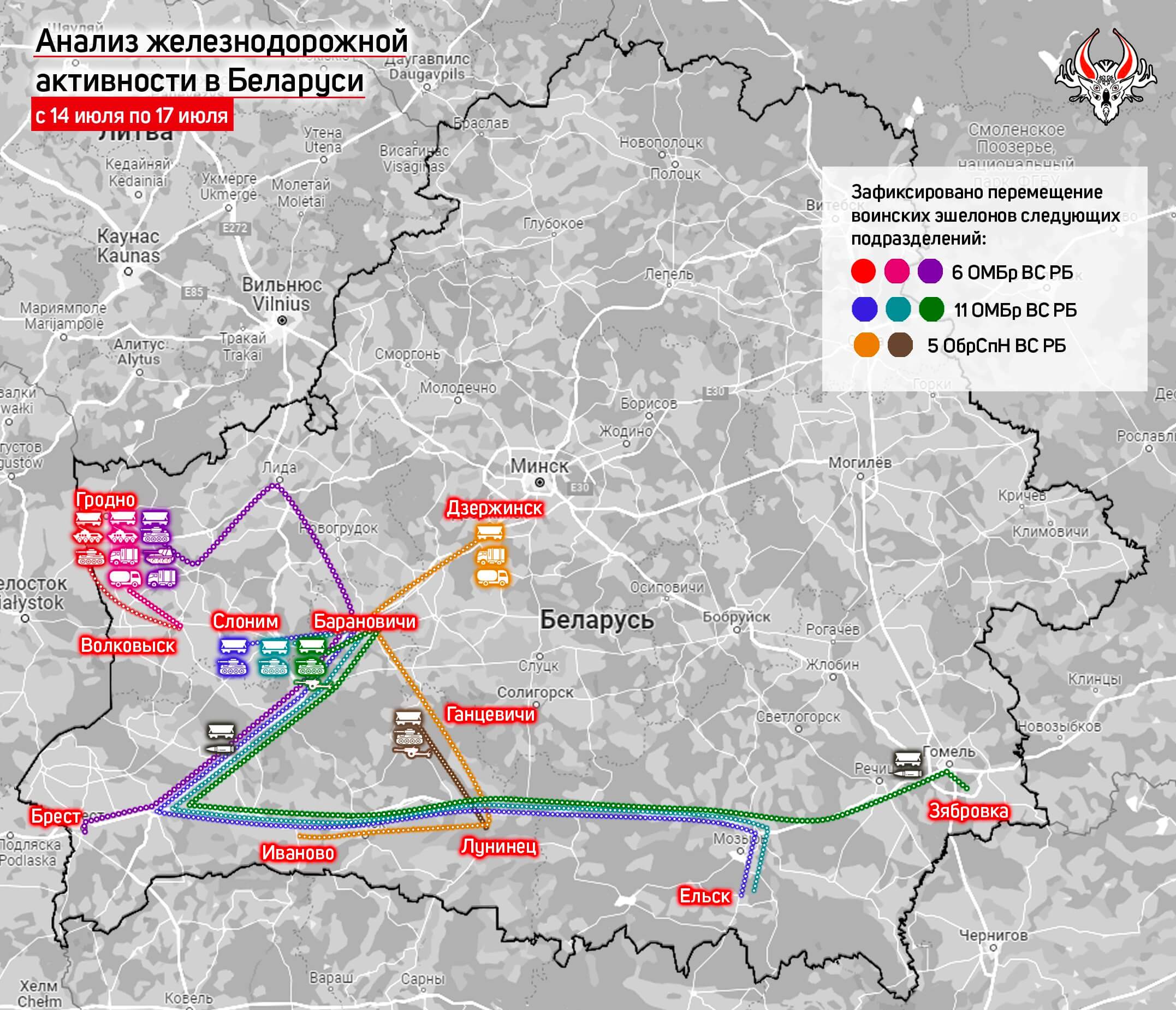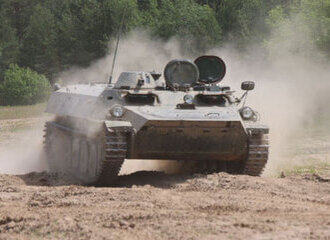Exercises of communication troops, operation of A-50 AEW&C aircraft, and arrival of Russian aircraft
Last week there was a significant aviation activity. From July 11 to July 17, 12 military transport aircraft of the Russian Aerospace Forces arrived at the military airfield in Machulishchy: 5 IL-76, 2 An-22 and 3 An-124. It should also be noted that on July 15, a Russian Air A-50 airborne early warning and control aircraft (RF-94268), which had arrived on July 9, left Belarus.
Active movements of columns with military equipment of the Belarusian Armed Forces continued. We may distinguish the following routes of movements: Minsk-Brest, Minsk-Grodno, Kalinkavichy-Mazyr, Gomel-Zhlobin-Minsk, Zhytkavichy-Petrykau, Rechitsa-Gomel, Minsk-Slutsk, Hantsavichy-Luninets, Babruisk-Mazyr, Zhytkavichy-Turau, Luban-Zhytkavichy, etc.
The columns included MAZ, KamAZ, ZiL-131, Ural, GAZ-66, Volat (MZKT) trucks, UAZ vehicles (Bukhanka vans, off-road vehicles), logistics equipment (field kitchens, fuel trucks), special electronic warfare and communications equipment (command posts, radio relay stations, R-434 «Citrus» radars). We also noted the transportation of artillery ammunition (from the village of Barouka, Lepel district), as well as single armored vehicles on trailers (for example, BREM-80U).
During the week, separate vehicles of the Belarusian Armed Forces were seen in Zhytkavichy, Khoiniki, Petrykau, Mazyr, Yelsk (Gomel region), Baranavichy, Stolin, Brest, Grodno (incl. near the railway station), Grodno region, Minsk (in the city and on the MKAD), Kirausk (Mogilev region) and Vitebsk.
There were also movements of columns with military equipment. The main routes were: Barysau — the 227th training ground, Malaryta-Brest, Minsk-Baranavichy, Ivanava-Pinsk, Kobryn-Brest, Kobryn-Malaryta, Babruisk-Slutsk, Yelsk railway station-Bouharka. As part of the columns were: air defense equipment (S-300 SAM systems and trailers with missiles to them, Osa SAM systems and transport loading vehicles to them), armored vehicles (T-72B tanks, BMP-2, BTR-80, BRDM, armored vehicles of various modifications), artillery systems (152-mm 2A65 Msta-B howitzer, 122-mm Grad MRL, 122-mm D-30 howitzer, transport loading vehicles for 220-mm Uragan MRL).
Insignificant activity of movements of the Russian Armed Forces was also recorded. For example, separate vehicles were seen in Mazyr, at Ziabrauka and Gomel-Passenger railway stations (Gomel region), as well as along the Kalinkavichy-Mazyr and Minsk-Maryina Horka routes.
We can note that the vast majority of military equipment movements of the Belarusian Armed Forces were supply convoys. No significant amount of ammunition was transported. This is explained by the ongoing conduct by the Belarusian Armed Forces of their tasks to protect the state border. It is also notable that some units of the Belarusian Armed Forces were used to participate in propaganda events (for example, here and here), which also resulted in additional troops movements in the southern regions of Belarus. It is known that units of the 6th Mechanized Brigade, 11th Mechanized Brigade and 38th Airborne-Assault Brigade participated in such events.
No significant movements of combat equipment by road were observed. However, there was an active redeployment of units of the Belarusian Armed Forces by rail (detailed analysis below).
We note that movements of the Belarusian Armed Forces are localized mainly in Brest, Gomel, and Minsk regions. We should also note that the activity of movements of equipment of communication troops was due to tactical-special training held from July 11 to July 15. For example, there is information about the participation of the 127th Communication Brigade (territorial) in the training.
It is worth noting that the activity of movements of columns of the Russian Armed Forces remains low. At the same time, the activity of military transport aviation is high, which can be explained by the supply of the remaining group of the Russian Armed Forces in Belarus.
Redeployment of equipment to the southern regions and withdrawal of ammunition to Russia
Analysis of railway activity in Belarus
Analysis of rail activity in Belarus from July 11 to July 17 / Belarusian Hajun Project
Over the past week, the monitoring team of the Belarusian Hajun Project has recorded an increase in the movement of military equipment by rail in Belarus. The peak was observed on July 15-16, and the main forces were redeployed to Yelsk, Brest, and Vaukavysk, and a little less to Ziabrauka and Ivanava.
Most part of the military equipment has been relocated to the border regions. The movement of military echelons of the following units was recorded:
- The 6th Separate Guards Mechanized Brigade (6 OMBr of the Belarusian Armed Forces) from Grodno to the Brest training ground, as well as to Vaukavysk, Slonim, and from there to Ziabrauka;
- The 11th Separate Guards Mechanized Brigade (11 OMBr of the Belarusian Armed Forces) from Slonim to Yelsk;
- The 5th Separate Special Operations Brigade (5ObrSpN of the Belarusian Armed Forces) from Maryina Horka to Ivanava.
Most of the vehicles were tracked ones: T-72b and T-72b3 tanks, BMP-1 and BMP-2 infantry fighting vehicles, MT-LB multipurpose floating armored personnel carriers, and the 122-mm 2S1 Gvozdika self-propelled howitzer.
The chronology of movement of echelons was as follows:
July 14:
- Evening. Departure of an echelon of the 11th OMBr of the Belarusian Armed Forces from Slonim (Grodno region);
July 15:
- Afternoon. Arrival of the echelon of the 11th OMBr of the Belarusian Armed Forces to Yelsk (Gomel region), and later the equipment moved to the area near the village of Bouharka (Yelsk district, Gomel region);
- Evening. Departure of the echelon of the 11th OMBr of the Belarusian Armed Forces from Slonim (Grodno region);
- Evening. Departure of the second echelon of the 11th OMBr of the Belarusian Armed Forces from Slonim (Grodno region);
- Evening. Departure of the second echelon of the 6th OMBr of the Belarusian Armed Forces from Grodno (Grodno region);
- Evening. Arrival of the second echelon of the 6th OMBr of the Belarusian Armed Forces to Vaukavysk (Grodno region);
July 16:
- Morning. Departure of an echelon of the 5th ObrSpN of the Belarusian Armed Forces from Dziarzhynsk (Minsk region);
- Afternoon. Arrival of the second echelon of the 11th OMBr of the Belarusian Armed Forces to Yelsk (Gomel region), later the equipment moved to the area of the village of Bouharka (Yelsk district, Gomel region);
- Evening. Arrival of the echelon of the 6th OMBr of the Belarusian Armed Forces to Ziabrauka (Gomel district, Gomel region), later the equipment moved towards the Chernihiv highway;
- Evening. Arrival of the echelon of the 5th ObrSpN of the Belarusian Armed Forces to Ivanava (Brest region);
- Evening. Departure of the third echelon of the 6th OMBr of the Belarusian Armed Forces from the village of Machulina (Vaukavysk district, Grodno region), it was moving towards Vaukavysk.
- Evening. Departure of the fourth echelon of the 6th OMBr of the Belarusian Armed Forces from Grodno.
July 17:
- Afternoon. Arrival of the fourth echelon of the 5th ObrSpN of the Belarusian Armed Forces to Brest, later all the equipment moved to the Brest training ground.
- Afternoon. An echelon with military equipment was moving through Hantsavichy (Brest region) towards Luninets.
What else has been transported by rail in the past week?
On July 14, another train carrying explosive materials, simply put, ammunition, was sent from Bronnaya Hara railway station to Russia. The train was loaded at the 46th arsenal in the village of Bronnaya Hara near Biaroza. On July 17, a train of the Russian Railways consisting of many freight cars, which could also carry ammunition, was seen at Prybor railway station. It is likely that the transportation of ammunition from Belarus to Russia takes place because of the shortage of shells in the Russian Armed Forces, especially after the destruction of storages on the occupied territory of Ukraine.
Also, in addition to movements by rail, supply columns were moving by road in other directions. The equipment that was redeployed to the border areas with Ukraine can be called «offensive.» But given the active withdrawal of shells to Russia, the equipment of the Belarusian Armed Forces may simply have nothing to attack with. At least so far we can say that it is not supplied with a sufficient amount of ammunition for offensive operations. Thus, the movement of equipment to the border areas with Ukraine may be an element of «intimidation» in response to, for example, the mining of the Ukrainian-Belarusian border.
Will there be active offensive actions by Belarus against the territory of Ukraine?
Briefly, not yet. Forces have been redeployed, but for real offensive actions, the Belarusian Armed Forces need to empty all storages, which must also be brought to the border, having previously organized a safe ammunition storage. Air support is also necessary for a successful offensive operations. At the moment, in addition to the Belarusian Air Force, the Russian Aerospace Forces are training in Baranavichy. A certain minimum of takeoffs is required to make a pilot combat-ready. So far, there are few pilots in Belarus who meet this demands. We should not forget that an offensive operation requires a numerical superiority of 3-6 times. All this can be possible only with modern and competitive equipment, as well as trained and prepared army. Which is not happening at the moment.
In fact, as of today, the monitoring team of the Belarusian Hajun Project can see that the Belarusian Armed Forces have indeed transferred part of their heavy weapons to the border area without equipping them with ammunition. Troops can’t attack when they have nothing to shoot with.
The following scenarios may cause serious concern:
- Mass transportation of supplies and additional equipment to the southern regions of the country;
- Establishment of an ammunition storage/storages in the south of Belarus;
- Increased air training at southern airfields in Luninets, Ziabrauka, and Bokau.
So far, we have not seen any of this, but we remain vigilant and continue to monitor the situation.



